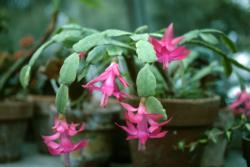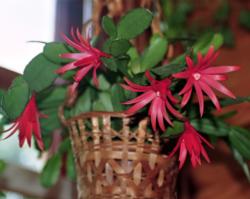Holiday cactus
-
Thanksgiving cactus or Christmas cactus (Schlumbergera X buckleyi) are versatile, long-lived and familiar cacti. In their native rainforests in Brazil, they grow as epiphytes (similar to epiphytic orchids), living on air, water and soil debris in trees and cracks in rocks. In Southern California they flower profusely in the winter months.

To grow in the ground or in pots, use a rich, porous soil mixture containing equal parts by volume of coarse sand, peat moss and leaf mold.These cacti have a spreading, arching, drooping habit and thick, fleshy dark green segmented leaves. Buds are produced at the end of the segmented stems and open to long, many-petaled, tubular flowers that come in purplish reds, pinks, and other colors.
Christmas cacti prefer partial shade or bright indirect light. They need regular water and excellent drainage. To ensure bud set for holiday flowering, provide cool nighttime temperatures (50 to 55 degrees F) and 12-14 hours of darkness per day beginning about 1 month prior to desired blooming. Fertilize frequently with liquid fertilizer during growth and blooming seasons.
These cacti also can be grown as houseplants in pots with porous, fertile soil, excellent drainage and bright indirect light. They bloom well when slightly crowded in their pots, and can be propagated by rooting a leaf segment in damp gravel or vermiculite.
During the summer months, when the plant is not in bloom, keep in a shady location and reduce water and fertilizer frequency.
The Easter cactus (Rhipsalidopsis gaertneri; Schlumbergera gaertneri) is a related plant that is also native to Brazil. This plant requires similar care as the Christmas cactus.
The Easter cactus is more upright in growth habit than the Christmas cactus, and usually blooms in spring. The flowers of the Easter cactus are rounder, and more daisy-like than tubular. There are several shades of red, pink and mauve. The Easter cactus also makes a good houseplant, or can live outside in Southern California.


